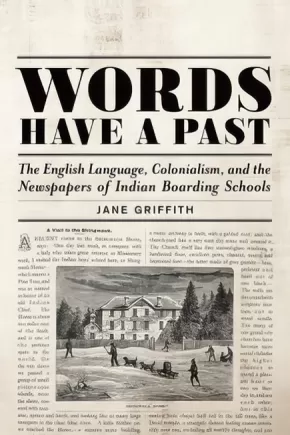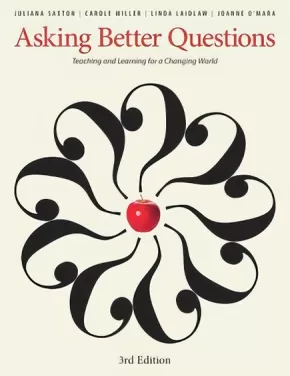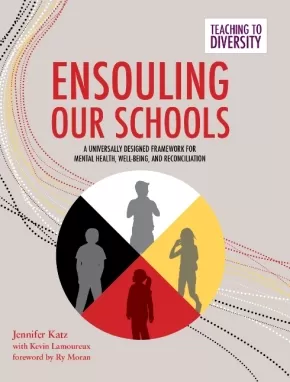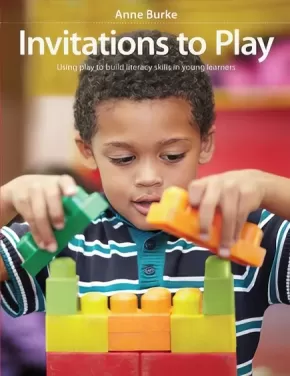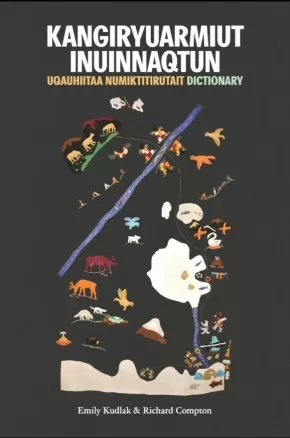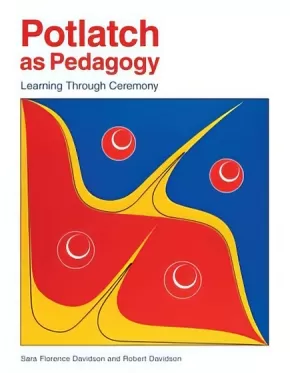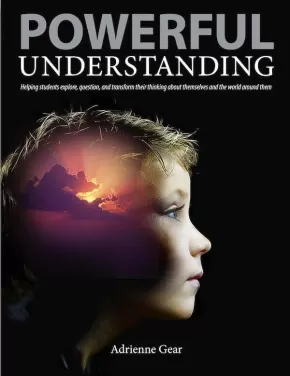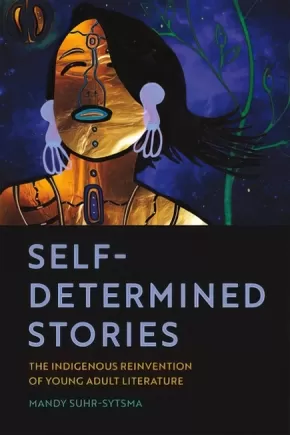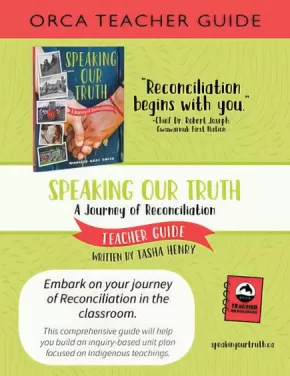Educator Resources
Synopsis:
For nearly 100 years, Indian boarding schools in Canada and the US produced newspapers read by white settlers, government officials, and Indigenous parents. These newspapers were used as a settler colonial tool, yet within these tightly controlled narratives there also existed sites of resistance. This book traces colonial narratives of language, time, and place from the nineteenth-century to the present day, post-Truth and Reconciliation Commission.
Educator Information
1. Bury the Lede: Introduction
2. Printer’s Devil: The Trade of Newspapers
3. Indigenous Languages Did Not Disappear: English Language Instruction
4. "Getting Indian Words": Representations of Indigenous Languages
5. Ahead by a Century: Time on Paper
6. Anachronism: Reading the Nineteenth Century Today
7. Layout: Space, Place, and Land
8. Concluding Thoughts
Additional Information
256 pages | 6.00" x 9.00"
Synopsis:
Teaching and learning for a changing world
How do we help students makes sense of our increasingly complex digital world? This third edition of this classic text shows teachers how to empower students with the skills they need to ask critical and reflective questions about the overwhelming amount of information around them.
Asking Better Questions offers comprehensive tools and strategies to promote critical thinking and discussion in the classroom and encourage engaged and empathetic listening. Stimulating activities throughout the book promote lifelong inquiry skills that will help teachers and students grow in the classroom and explore broader issues in the community beyond. Challenge your students to assume a deeper ownership of their learning, ask questions that are important to them, and care about the answers.
On Twitter: #ABQ3
Educator Information
For students 5 - 14.
Additional Information
160 Pages
Synopsis:
Within Dropping the “T” from CAN'T, Dr. Michelle Hogue presents and analyses interviews with eight highly successful Indigenous women and men in order to discern what enables Indigenous people to become successful in the sciences and mathematics such that they are able to pursue related professions. Importantly, Dr. Hogue presents interviews with two Indigenous individuals who started yet did not complete advanced degrees in order to find out what impediments brought their academic journeys to a premature end.
Dr. Hogue’s interview findings, paired with current and relevant literature, serves to enlighten and support the Truth and Reconciliation Commissions Calls to Action to provide culturally relevant education for Aboriginal learners. Education must be culturally and holistically relevant in order to invite, engage, and enable learners; this is true of both Aboriginal and non-Aboriginal learners. While this book specifically examines science and mathematics education, the lessons and findings will apply across disciplines.
Foreword by Dr. Laara Fitznor. Reviews by: Dr.'s Cheryl Bartlett, Fidgi Gendron, Yvonne Poitress Pratt, and Leroy Little Bear.
Reviews
"Indigenous students CAN succeed in post-secondary science and mathematics! This is the clear message in Dr. Hogue’s book. Recognizing, reshaping, and retelling insights about success within personal stories requires a skillful story worker and Dr. Hogue is superb. Using the Medicine Wheel, she conveys understandings ‘wholistically’ to provide the much-needed complement to institutional STEM pathways and programs. Hers is a book for everyone: students, educators, academics, administrators, leaders, funders, parents, youth ..." — Cheryl Bartlett
"What a refreshing book! Michelle Hogue celebrates Aboriginal women and men who journeyed through post-secondary education in science and mathematics and achieved their dreams. She examines their successes and challenges and highlights how Aboriginal science and Western science can come together to reach inclusive learning and knowing. These stories will inspire not only Aboriginal people but everybody to not give up and work hard to reach their goals." — Fidji Gendron
"As educators continue to ask how all subject areas can be Indigenized, Hogue steps into contested teaching and learning territory with the same fearless attitude she takes in teaching math and science from an Indigenous perspective. This fascinating book contains insights and stories from Indigenous scientists providing irrefutable evidence there is no anomaly between being Indigenous and being a scientist." — Yvonne Poitras Pratt
"Michelle is an extremely good writer. I can tell she put a tremendous amount of research into the book. I very much like her layout of the Medicine Wheel into: Spring, Summer, Fall, and Winter. Doing so clearly brings out the barriers to science education for Indigenous students. Overall, the book makes the point that the ’T’ can be dropped from CAN’T providing we know the culture of Indigenous students and the struggles they have to go through to fulfill their personal goals of becoming scientists." — Leroy Little Bear
Educator Information
Table of Contents
Acknowledgements and Dedication
A Note on Terms
Table of Contents
Foreword, By: Laara Fitznor, EdD
Preface: Tan’si, Hello
SPRING
Prologue
Introduction: The Environment
Puzzlements and Questions
SUMMER
Women’s Journey
Men’s Journey
Re-framing the Journey
The Talking Circle
FALL
Understanding the Space Between
Navigating the Space Between
WINTER
Coming to Understand
Philosophically Navigating
Reframing: Coming Full Circle
A NEW CYCLE
Bridging Cultures, Two-Eyed Seeing & the 21st Century
Final Reflections
The Equation for Success
Appendix
References
Index
About the Author
Additional Information
199 pages | 6.00" x 9.00"
Synopsis:
In an educational milieu in which standards and accountability hold sway, schools can become places of stress, marginalization, and isolation instead of learning communities that nurture a sense of meaning and purpose. In Ensouling Our Schools, author Jennifer Katz weaves together methods of creating schools that engender mental, spiritual, and emotional health while developing intellectual thought and critical analysis.
Kevin Lamoureux contributes his expertise regarding Indigenous approaches to mental and spiritual health that benefit all students and address the TRC Calls to Action.
Grade: For all teachers
Reviews
Additional Information
200 pages | 8.00" x 10.50"
by Jennifer Katz | with Kevin Lamoureux | foreword by Ry Moran
Synopsis:
Indigenous perspectives much older than the nation itself shared through maps, artwork, history and culture.
The Royal Canadian Geographical Society, in partnership with Canada's national Indigenous organizations, has created a groundbreaking four-volume atlas that shares the experiences, perspectives, and histories of First Nations, Inuit and Métis peoples. It's an ambitious and unprecedented project inspired by the Truth and Reconciliation Commission's Calls to Action. Exploring themes of language, demographics, economy, environment and culture, with in-depth coverage of treaties and residential schools, these are stories of Canada's Indigenous Peoples, told in detailed maps and rich narratives.
This extraordinary project offers Canada a step on the path toward understanding.
The volumes contain more than 48 pages of reference maps, content from more than 50 Indigenous writers; hundreds of historical and contemporary photographs and a glossary of Indigenous terms, timelines, map of Indigenous languages, and frequently asked questions. All packaged together in a beautifully designed protective slipcase.
Educator Information
Recommended for ages 13+.
The Indigenous Peoples Atlas of Canada includes a four volume print atlas, an online atlas, an app, and more!
Additional Information
322 pages | 10.50" x 12.87"
Synopsis:
Using play to build literacy skills in young learners
Our youngest learners thrive when their learning environment is one that celebrates curiosity, exploration, and imagination. This comprehensive resource sets the stage for play-based learning that will help children build a strong literacy foundation, as well as successfully negotiate the choices they make in real life.
A perfect blend of theory and instruction, Invitations to Play offers background and strategies for you to explore all aspects of playful learning. It shows you how to
- incorporate digital literacy — choose and use apps that will access children’s imaginary worlds and promote creative collaboration
- use music to develop sensory and collaborative learning — create music play centres that include making instruments from household items
- build on student home languages and ideas — guide children into English knowledge through social and collaborative interactions
- nurture multiple literacies — innovative ways to use play as scaffolding for later explorations in literacy
Invitations to Play gives new and experienced teachers a road map to involve and engage their young students in all forms of literacy learning.
Additional Information
160 pages | 8.40" x 10.80"
Synopsis:
The product of intensive, highly detailed work, this dictionary is more than a language document. It is a unique window into the Inuinnait culture and way of life.
Kangiryuarmiut Inuinnaqtun Uqauhiitaa Numiktitirutait - Kangiryuarmiut Inuinnaqtun Dictionary details the Kangiryuarmiut dialect of Inuinnaqtun, as spoken in the community of Ulukhaktok in the Inuvialuit Region of Canada's Northwest Territories. Very similar dialects of Inuinnaqtun are spoken in Qurluqtuq (Kugluktuk) and Iqaluktuuttiaq (Cambridge Bay) in Nunavut.
This is the most comprehensive dictionary of any Western Canadian dialect of the Inuit language. It contains over 5,000 Inuinnaqtun entries and subentries with their translations, over 3,000 example sentences, and a large inventory of suffixes.
The introduction includes a brief overview of Inuinnaqtun, its sound system, orthography, and major word classes. Main entries include both related subentries and examples. Suffix entries include information about lexical categories, inflection, the different forms a suffix may take, and examples of how each suffix is used.
Additional Information
582 pages | 6.50" x 9.50" | English, Inuinnaqtun
Synopsis:
How do we ensure that all students are engaged each day in meaningful, challenging, and joyful work and have equal opportunity to learn?
That is the central question Regie Routman addresses in Literacy Essentials: Engagement, Excellence, and Equity for All Learners. Her response is that such an outcome is only possible within a culture of empowerment in which all students and teachers feel encouraged and supported to let their voices be heard, explore their passions and interests, develop deep knowledge, and become their fullest and truest selves.
Based on her ongoing teaching, leading, and coaching in diverse schools and districts, Regie offers K-12 teachers and leaders practical, easy-to-implement tools to help students develop as self-determining readers, writers, and learners including:
- Take Action sections with specific suggestions for authentically teaching, assessing, and learning
- Extensive research that is easily accessible and actionable
- Personal stories that connect to literacy teaching and learning
- Rich online resources including a comprehensive lesson plan, an easy-to-use study guide, downloadable Appendices, and more.
Literacy Essentials shows what’s possible when teachers and schools raise expectations for all students and create an intellectual culture based on trust, collaborative expertise, and celebration of learners’ strengths.
Educator Information
Audience Range: Ages 5-17
Additional Information
482 pages | 7.30" x 9.20"
Synopsis:
Inspired by Haida ceremonial practice, father and daughter present a model for learning that is holistic, relational, practical, and continuous.
In 1884, the Canadian government enacted a ban on the potlatch, the foundational ceremony of the Haida people. The tradition, which determined social structure, transmitted cultural knowledge, and redistributed wealth, was seen as a cultural impediment to the government’s aim of assimilation.
The tradition did not die, however; the knowledge of the ceremony was kept alive by the Elders through other events until the ban was lifted. In 1969, a potlatch was held. The occasion: the raising of a totem pole carved by Robert Davidson, the first the community had seen in close to 80 years. From then on, the community publicly reclaimed, from the Elders who remained to share it, the knowledge that has almost been lost.
Sara Florence Davidson, Robert’s daughter, would become an educator. Over the course of her own education, she came to see how the traditions of the Haida practiced by her father—holistic, built on relationships, practical, and continuous—could be integrated into contemporary educational practices. From this realization came the roots for this book.
Reviews
"Potlatch as Pedagogy is wonderfully wise, hopeful, heartful, eloquent, and loving! Every teacher candidate and teacher needs to read this book. The authors expertly evoke the history and culture of the Haida as they call forth the sadness as well as the hope and joy of generations of people who were misunderstood and mistreated. In this time of Truth and Reconciliation, we all need to attend to this book." —Dr. Carl Leggo, Professor, Department of Language and Literacy Education, University of British Columbia
Educator Information
For all teachers.
Recommended in the Canadian Indigenous Books for Schools 2019-2020 resource list as a Teacher Resource for grades 10 to 12 with reference to Social Studies.
Additional Information
200 pages | 7.00" x 9.00"
Synopsis:
Helping students explore, question, and transform their thinking about themselves and the world around them.
In these challenging times, teaching children to think critically and reflectively AND be compassionate, responsible and caring citizens at the same time is a tall order. Powerful Understanding explores effective ways to build social-emotional skills and help students make connections, question what they read, and reflect on their learning as they develop into stronger readers and learners. Strategic and critical thinking strategies revolve around core anchor books that help integrate thinking into everything you teach—from social responsibility, to immigration, to life cycles. This highly readable book includes a wealth of classroom examples and extensive hands-on activities designed to help students to think more deeply, learn more widely, and develop a more powerful understanding of what it means to be a responsible and compassionate person.
Educator Information
Grade Range: K-8
Table of Contents
Preface
Introduction
Chapter 1: The Components of Powerful Understanding
Chapter 2: Lessons on Understanding Self
Chapter 3: Lessons on Understanding Others
Chapter 4: Lessons on Understanding the World
Final Thoughts
Acknowledgments
Professional Resources
Index
Additional Information
160 pages | 8.30" x 10.80"
Synopsis:
Reimagining Indigenous empowerment.
The first book of its kind, Self-Determined Stories: The Indigenous Reinvention of Young Adult Literature reads Indigenous-authored YA-from school stories to speculative fiction-not only as a vital challenge to stereotypes but also as a rich intellectual resource for theorizing Indigenous sovereignty in the contemporary era.
Building on scholarship from Indigenous studies, children’s literature, and cultural studies, Suhr-Sytsma delves deep into close readings of works by Sherman Alexie, Jeannette Armstrong, Joseph Bruchac, Drew Hayden Taylor, Susan Power, Cynthia Leitich Smith, and Melissa Tantaquidgeon Zobel. Together, Suhr-Sytsma contends, these works constitute a unique Indigenous YA genre. This genre radically revises typical YA conventions while offering a portrayal of Indigenous self-determination and a fresh critique of multiculturalism, heteropatriarchy, and hybridity. This literature, moreover, imagines compelling alternative ways to navigate cultural dynamism, intersectionality, and alliance-formation.
Self-Determined Stories invites readers from a range of contexts to engage with Indigenous YA and convincingly demonstrates the centrality of Indigenous stories, Indigenous knowledge, and Indigenous people to the flourishing of everyone in every place.
Contents
Introduction
Ch. 1: A Rebel with a Community, Not Just Cause: Revising YA Power Dynamics and Uniquely Representing Indigenous Sovereignty in Jeannette Armstrong's Slash
Ch. 2: Indigenous School Stories: Alternatives to Multiculturalism in Sherman Alexie's The Absolutely True Diary of a Part-Time Indian and Joseph Bruchac's The Heart of a Chief
Ch. 3: Not Your Father's Pocahontas: Cynthia Leitich Smith's and Susan Power's Resistive Romance
Ch. 4: That's One Story: Reworking Hybridity through Melissa Tantaquidgeon Zobel's and Drew Hayden Taylor's Speculative Fiction
Coda: Alexie's Flight, Zobel's Wabanaki Blues, and the Future of Indigenous YA Literature
Additional Information
214 pages | 6.00" x 9.00"
Synopsis:
Speaking Our Truth: A Journey of Reconciliation is a nonfiction book for middle readers that examines how we can foster Reconciliation in an accessible way. Centered around the writings of Monique Gray Smith, this teacher guide is a comprehensive support for educators focusing on Indigenous teachings and looking to build an inquiry-based unit plan about Reconciliation. Activities such as essential questions from the author, metaphors for learning and cross-curricular plans are laid out clearly, with instructions and appropriate vocabulary for teachers and students to embark on this journey of Reconciliation together.
Educator Information
This resource helps teachers embark on a journey of Reconciliation in the classroom. The author, Tasha Henry, holds a Master of Education in Language, Culture and Teaching from York University and has been teaching for over twenty years.
Recommended in the Canadian Indigenous Books for Schools 2019-2020 resource list as being a useful Teacher Resource with regard to English Language Arts, Social Justice, and Social Studies.
Find the student resource here: Speaking Our Truth: A Journey of Reconciliation
Additional Information
46 pages | 8.50" x 11.00"
Synopsis:
What do you need for a well-run classroom full of engaged students? Kathy Lundy takes you step-by-step through the nitty-gritty details of creating a classroom that works for you and your students. This honest look at the complexity of teaching introduces you to strategies that work and classroom management tips that make a difference. From building a safe and inclusive classroom, to teaching with imagination and innovation, to engaging with your mentors, Stand Up & Teach will help you become the teacher you want to be.
Educator Information
Targeting youth ages 5-17.
Additional Information
128 pages | 8.30" x 10.80"
Synopsis:
Ask successful writers and they’ll tell you, the key to writing well is revision. Ask elementary school teachers and they’ll tell you, the real challenge of writing instruction is teaching kids how to revise. Ruth Culham is both a successful writer and a writing teacher, and she’s discovered how to teach writing and revision in a way that’s accessible to both teacher and students: First read the writing, assess it using the traits of writing, then teach the writers and guide revision decisions using traits as a common language and map.
This book shows you how to assess and teach writing in a way that’s practical and doable—and best of all, see results. Traits-based revision lies at the heart of this book, as it’s been at the heart of Ruth’s career in writing instruction. Rethinking revision is what will ultimately help you to Teach Writing Well.
Educator Information
Part 1 walks you through the traits of writing and their key qualities, showing step by step how to read students’ writing and offer feedback that nudges them forward through the revision process. Chapters will help you address challenges students face within each mode of writing (narrative, expository, persuasive), and provide tools young writers can use to evaluate their own writing and make revision decisions accordingly.
Part 2 dives into instruction, offering specific guidance for how to use what you’ve learned from reading student writing to design lessons that scaffold students toward making their own craft decisions and revisions. In addition, there’s an entire chapter devoted to mentor texts that you can use to model traits and key qualities for your students.
Grade Range: 2-6
Additional Information
224 pages
Synopsis:
Like the night sky above, Tipiskawi Kisik holds a myriad of tales rooted in an Ininew (Cree) perspective. An exploration of stars and constellations—and their associated mythologies—will greet you with age-old knowledge held by Indigenous people prior to European contact. Through Wilfred Buck’s creative, spiritual, and intelligent understanding of the stars, it will be easy to imagine yourself flying inside the Milky Way with Niska (the Goose) or chasing Mista Muskwa (the Great Bear), just like Tepakoop Pinesisuk (the Seven Birds). Above all, these stories can be passed on to the next generation, so they will know of the rich history, science practices, and culture of the Ininew people.
Additional Information
This is a collection of short stories (approximately 25 pages long) with supporting artwork/illustrations. While not aimed at young readers in terms of reading level, this book would support educators in their teaching of Indigenous astronomy to younger audiences, especially since each short story would work well as a read aloud and includes useful illustrations/diagrams of the night sky.

